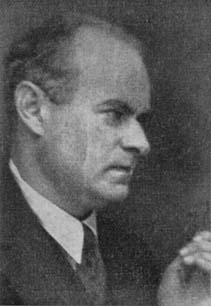
Aron Nimzowitsch
Edward Winter

Aron Nimzowitsch
‘The most remarkable winning move on record’ was Reuben Fine’s description of 25...h6 in the ‘Immortal Zugzwang Game’ (page 130 of his 1951 book The World’s Great Chess Games). On page 32 of Fifty Great Games of Modern Chess, Harry Golombek called it the ‘finest possible example of Zugzwang’. Fred Reinfeld considered it Nimzowitsch’s ‘most famous game’ (Great Moments in Chess, page 107). As will be seen below, all that may or may not be true, but initially the game was virtually ignored by the chess world.
First, for ease of reference, the moves:
Friedrich Sämisch – Aron Nimzowitsch
Copenhagen, March 1923
Queen’s Indian Defence
1 d4 Nf6 2 c4 e6 3 Nf3 b6 4 g3 Bb7 5 Bg2 Be7 6 Nc3 O-O 7 O-O d5 8 Ne5 c6 9 cxd5 cxd5 10 Bf4 a6 11 Rc1 b5 12 Qb3 Nc6 13 Nxc6 Bxc6 14 h3 Qd7 15 Kh2 Nh5 16 Bd2 f5 17 Qd1 b4 18 Nb1 Bb5 19 Rg1 Bd6 20 e4 fxe4 21 Qxh5 Rxf2 22 Qg5 Raf8 23 Kh1 R8f5 24 Qe3 Bd3 25 Rce1
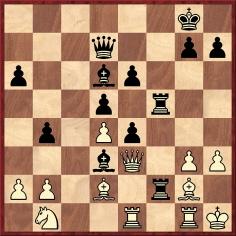
25...h6 26 White resigns.
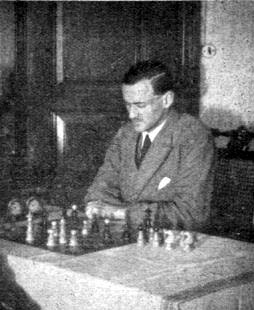
Friedrich Sämisch
It is tempting to imagine the game being instantly flashed around the planet as a unique specimen of hypermodern technique resulting in a hapless opponent being tied up, or down, hand-and-foot. In truth, the score is absent from almost all the major chess magazines of 1923 (e.g. Deutsche Schachzeitung, Wiener Schachzeitung, BCM, American Chess Bulletin and Tijdschrift van den Nederlandschen Schaakbond).
Nor did it appear in the 25-page ‘Games of 1923’ section in Chess of To-day by Alfred Emery (London, 1924) or, even, in Ludwig Bachmann’s Schachjahrbuch 1923 (published in Ansbach the following year), which had nearly 180 games. The year Nimzowitsch died, 1935, Reinfeld brought out a monograph entitled Thirty-five Nimzowitsch Games, 1904-1927, but there was still no ‘Immortal Zugzwang Game’. Some subsequent ‘standard sources’ also ignored it, an example being 500 Master Games of Chess by Tartakower and du Mont (London, 1952).
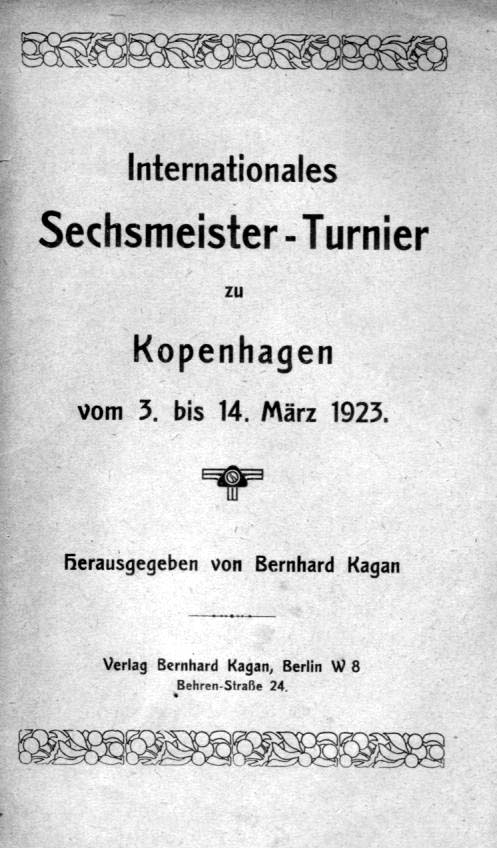
It was, at least, included in the Copenhagen, 1923 tournament book (page 23), albeit with a mere seven brief notes in Richard Teichmann’s characteristically desiccated style. Black’s 15th and 16th moves were allotted one exclamation mark apiece, but Teichmann showed little enthusiasm for the finale. The tournament book also came out as a supplement to the periodical Kagans Neueste Schachnachrichten, between the April 1923 and June 1923 issues, and Teichmann’s comments were used on page 106 of the July 1923 Časopis Československých Šachistů. It was hardly an auspicious start for the ‘most famous game’.
Eventually, Nimzowitsch went on a propaganda blitz. He burst into annotational song on pages 17-18 of the 2/1925 Wiener Schachzeitung under the heading ‘Zugzwang on a full board!’ Double exclamation marks accompanied Black’s 10th, 20th and 25th moves, and the high-spirited victor described 25...h6 as follows:
‘An exceptionally beautiful problem move! This puts White in nothing less than a tragic Zugzwang position (I won’t say tragicomic, since the sheer force of Black’s play rules out any thought of humour).
... In the opinion of the well-known Danish amateur master, the writer/editor Hemmer Hansen, this game would be worthy of being placed alongside the “Immortal Game”. While Anderssen was able to deploy the “sacrifice” as such to maximum benefit, I, Hansen said, achieved a similar effect with the Zugzwang. In Danish chess circles, this game is therefore described as the Immortal Zugzwang Game!’
Later that year, he continued in the same vein in his first book, Die Blockade (page 52), writing of 25...h6:
‘A brilliant move which announces the Zugzwang. ... This unusually brilliant Zugzwang mechanism makes this game, which Dr Lasker in a Dutch publication called a magnificent achievement, a counterpart to the “Immortal Game”. There the maximum effect of the “sacrifice”, here that of the “Zugzwang”.’
The Lasker article (in a Dutch newspaper?) has yet to be located.
Die Blockade was followed, also in 1925, by the first edition of Mein System, in which (page 55) Nimzowitsch had fresh words of acclaim for his performance:
‘... a short game, which is known far and wide as the “Immortal Zugzwang Game”. It is of interest to us because the outpost is used here merely as a threat or even just as a ghost. And yet its effect is enormous.’
It had been a quick transition from commendations in Danish and Dutch sources to recognition ‘far and wide’. Meeker sentiments by Nimzowitsch appeared in the English edition, My System, published in 1929, although that version did have his closing remark, ‘a brilliant move which announces the Zugzwang’.
The English translator of My System was Philip Hereford (i.e. Arthur Hereford Wykeham George, who died in 1937). His introduction, dated 29 August 1929, referred to Zugzwang as the only word left untranslated in the book, ‘partly since it is [sic] become familiar in English chess circles, partly, in fact mainly, because the single word conveys an idea, or complex of ideas, which can only be expressed in English by a circumlocution’.
In reality, the term Zugzwang was not commonly found in English-language chess literature prior to the publication of My System. In German, though, it had been in regular use in the nineteenth century. Pages 353-358 of the September 1858 Deutsche Schachzeitung had an unsigned article ‘Zugzwang, Zugwahl und Privilegien’. F. Amelung employed the terms Zugzwang, Tempozwang and Tempozugzwang on pages 257-259 of the September 1896 issue of the same magazine. When a perceived example of Zugzwang occurred in the third game of the 1896-97 world championship match between Steinitz and Lasker, after 34...Rg8, the Deutsche Schachzeitung (December 1896, page 368) reported that ‘White has died of Zugzwang’. As is shown, inter alia, by the appearance of that game in the Fine/Reinfeld collection of Lasker’s masterpieces, published in 1935, Zugzwang established itself in English-language chess sources in the 1930s.
Then came the quest for a satisfactory translation or circumlocution. The most frequent rendering nowadays is compulsion to move, but many fanciful proposals had to be endured first. Discussing the position reached after 40...Qe2 in Bogoljubow v Alekhine, Hastings, 1922, Brian Harley offered straight-waistcoat on page 27 of his 1936 book Chess and its Stars. That, in turn, was converted into US parlance as straightjacket by the American Chess Bulletin (July-August 1936 issue, page 120). On page 266 of the 14 March 1939 CHESS, H.G. Hart suggested move-bound. The same magazine (20 August 1939, page 438) recorded R.E. Kemp’s offering of squeezed, ‘in use in his club 45 years ago, long before Bridge-players took up the term for the exact parallel of this operation in their game’.
After the Second World War, Assiac (the pseudonym of Heinrich Fraenkel) organized a New Statesman and Nation competition to find a suitable translation of Zugzwang. As reported on page 54 of his book The Pleasures of Chess, the entries included plank-walk, movicide, goose-gang, gadarene-pull and dreadmill. Both squeeze and movebound were submitted, and the latter actually won first prize for Gerald Abrahams. H.G. Hart’s CHESS precedent had evidently been forgotten. Walter Korn went further in his book The Brilliant Touch in Chess (page 72), offering movebound, movestruck, movetight, off tempo, in a jam, in a squeeze and duress. At least part of the intention of all this was to elude a purportedly ugly-sounding German word.
Equivalents were sought in other languages too. In an article on page 173 of the September 1942 issue of the Argentinian magazine Caissa, Carlos Skalicka proposed semi-ahogado (Spanish for semi-stalemate). The same item maintained, on undisclosed grounds, that the term Zugzwang had been invented over 50 years previously by Hermann Zwanzig (1837-1894), and that Dufresne’s opinion was that it had ‘truly enriched the German language’.
A word is normally defined, or at least clearly understood, before it is translated, but with Zugzwang the contrary occurred. In an heretical article ‘That Zugzwang Nonsense!’ on pages 26-27 of the January 1972 BCM Wolfgang Heidenfeld (1911-80) threw a weighty spanner in the works:
‘The opponent’s Zugzwang – the compulsion (as opposed to the right) to make a move – enables a player to win – or draw, as the case may be – a position which he could not otherwise win or draw. If the opponent had the choice of moving or “passing” at his discretion, there would be no win or draw. Once this criterion is lacking there is no Zugzwang. There may be a complete blockade, with one side powerless to make any useful move – but this is no real Zugzwang.’
On this basis Heidenfeld denied that the Sämisch v Nimzowitsch game featured Zugzwang at all. Observing that in the final position it would be more advantageous for White to move (e.g. 26 Bc1 Bxb1 27 Rgf1) than to pass, he suggested that the ‘Immortal Zugzwang Game nonsense’ had resulted from ‘the vanity of Nimzowitsch’. He also disallowed Alekhine v Nimzowitsch, San Remo, 1930 as an example of Zugzwang, notwithstanding Alekhine’s claim in his second Best Games collection. Similar arguments were outlined by Andy Soltis on page 55 of Chess to Enjoy (New York, 1978), and the current hesitancy over the exact meaning of Zugzwang is highlighted by the contrasting entries for the word in the 1984 and 1992 editions of The Oxford Companion to Chess.
The debate is far from over, but in the meantime some further oddities about the Sämisch v Nimzowitsch game may be recorded here. Although it apparently won no brilliancy prize, Ludwig Steinkohl put it in his 1995 book 99 Schönheitspreise aus 150 Schachjahren, calling the opening the Catalan, rather than the Queen’s Indian Defence. Al Horowitz’s book All About Chess gave it twice, with two different introductions. In presenting the closing position, Chess Techniques by A.R.B. Thomas reversed the colours, stating that Nimzowitsch, as White, won with the concluding move h3. (It is true, however, that in an earlier round the two masters had played the same opening against each other, with opposite colours and a minor transposition, up to White’s eighth move.) Aaron Nimzowitsch Ein Leben für das Schach by Gero H. Marten (page 147) asserted that Sämisch thought for an hour before resigning, whereas on page 443 of Die Hypermoderne Schachpartie Tartakower, a participant in the Copenhagen, 1923 tournament, wrote that Sämisch overstepped the time-limit. Although Tartakower concluded that page with the words ‘The Immortal Zugzwang Game’, they were indented and in quotation marks, not necessarily suggesting that Tartakower himself had originated the epitaph as is sometimes believed.

Copenhagen, 1923. Seated from left
to right: A. Nimzowitsch, R. Spielmann, J.
Møller, F. Sämisch
Standing: S. Tartakower, O. Rützou, E.
Jacobsen. (See C.N. 7242.)
Just as sacrifices are attractive because possession of material is usually an advantage, the appeal of Zugzwang is that possession of the move is almost invariably desirable. Difficult to define and translate, Zugzwang is, in all its possible forms, easy to enjoy. As the prize-winning Gerald Abrahams suggested on page 38 of Brilliance in Chess (London, 1977), ‘of all chess situations, Zugzwang is the one most likely to stimulate mirth’.
***
The above article first appeared at the Chess Café in 1997.
Concerning the reference above to Chess Techniques, in his Introduction (page ix) A.R.B. Thomas explained why, in many cases, he had reversed the colours. See C.N. 8977.
Afterword (C.N. 2929, in May 2003):
Per Skjoldager (Fredericia, Denmark) writes to us as follows:
‘You list many major chess periodicals from which the “Immortal Zugzwang Game” was absent. I think it is even more remarkable that it was also absent from the Scandinavian chess magazines Skakbladet, Norsk Schakblad and Tidskrift för Schack.
You mention Hemmer Hansen, and I can confirm that he did indeed write something similar to the words attributed to him by Nimzowitsch. In an article on the Copenhagen tournament in Jyllands-posten, 12 April 1923 he gave the following account of Nimzowitsch’s win in the game in question:
“His game in Copenhagen against Sämisch is actually of the same rank as Anderssen’s famous Immortal Game. The difference, however, is that while Anderssen was trying to mate his opponent with his combinations, Nimzowitsch tries to paralyse his opponent’s forces. In the game mentioned he sacrifices a piece and with his own five pieces he puts six enemy pieces into such deep disarray that Sämisch resigned the game long before mate was in sight.”
Yet we still lack proof that “Danish chess circles” recognized the game as the “Immortal Zugzwang Game”.
I can also report that Emanuel Lasker annotated the game in De Telegraaf, 2 June 1923. The item was found by Piet Zwetsloot and Wim Nijenhuis. After 25...h6 Lasker wrote:
“In this remarkable position all White’s pieces are stalemated. For example: 26 g4 R5f3! or 26 Kh2 R5f3! So White can only make a few pawn moves. Therefore White resigned here.”
It will be noted that Lasker referred only to a “remarkable position”, whereas Nimzowitsch quoted him as calling the game a “magnificent achievement”. But, of course, this article may not be the only place where Lasker wrote about the game.
The exact date of the game can be mentioned here, i.e. 10 March 1923 according to Jyllands-posten of the following day.
You discussed the varying accounts of how the game ended. This is what appeared in an article in the newspaper Politiken on 11 March 1923:
“Sämisch ponders for so long that he falls into time-trouble. However, his efforts cannot save him from the fateful dilemma and since the loss of the queen is inevitable in only two more moves [sic], he resigns the game, which has lasted for 26 moves in total.”’
We would add that one of the very few chess magazines to publish the score in 1923 was The Chess Amateur. Some eight months after the game had been played the November 1923 issue (page 37) gave the ‘score and notes from an excellent column which seems to be edited by the Hastings Chess Association’. The latter publication was quoted as saying that the game contained ‘a most subtle sacrifice leading to a curious finish’, and the move 25…h6 was given two exclamation marks with the following note: ‘White must either give up the queen (…Rf3 is threatened) or else give up a piece to allow the queen to retreat!’
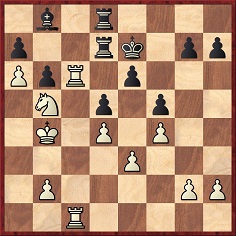
H. Nowarra-Galgan, Correspondence game, 1939-40
White continued 1 Nc7 Bxc7 2 Rxc7 Rxc7 3 Rc7+ Rd7 4 Rb7 Kd6 5 Kb5 Rxb7 6 axb7 Kc7 7 Ka6 Kb8, and he now played what he described as the only move to win ...
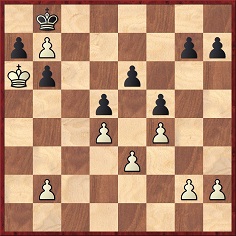
... 8 b3.
Source: Deutsche Schachblätter, 1 October 1940, page 161.
(2399)
We are looking for instances of the word Zugzwang occurring in non-German-language sources prior to the 1920s. For example:
‘Several of Capablanca’s games had a spice of humor in them, notably those with Phillips and Marder, the latter being wound up with a “Zugzwang” position.’
Source: American Chess Bulletin, September 1913, page 193.
(2686)
‘Here we see the zugs-zwang completed.’
W.E. Napier, the Chess Weekly, 6 June 1908, page 3.
The same unusual spelling appeared on page 25 of the 19 June 1909 issue.
Paul Pridmore (Southampton, England) sends us an even earlier citation, i.e. page 166 of the February 1905 Lasker’s Chess Magazine (i.e. the final note, after 50…f6, to the third game of that year’s Marshall v Janowsky match):
‘White has struggled bravely and only loses by “Zugzwang”.’
We can add that Lasker also wrote the following on page 128 of the September 1908 issue of his magazine:
‘White can only win by “Zugzwang”.’
Moreover, the earliest non-German-language source for the word that we have found so far is on page 129 of the 15 May 1901 issue of La Stratégie, where it cropped up twice in an account of a problem tourney. The spelling was ‘Zugsvang’ in the main text and ‘Zugsvand’ in the explanatory footnote.
(2718)
From Christian Sánchez (Rosario, Argentina):
‘Leafing through the book Camino fácil del ajedrez by B.H. Wood (Buenos Aires, 1944) I came across this paragraph (page 138):
“El jugador que se encuentra en el infortunado trance de acelerar su propio desastre por tener que jugar forzosamente, se halla en ‘Zugzwang’ (palabra alemana que significa “obligación de mover”), o llamado también ‘movida límite’.”
As I have never heard or read the expression “movida límite” I wonder if it is a literal translation from the English, if the translator created it ad hoc or if it was indeed used in Argentina at that time. In any case, the meaning is not clear: limit move?, extreme move?
Wood gives as an example of Zugzwang the position in the game Sämisch v Nimzowitsch before the move 25...h6; however, the situation of the pawns on the queen’s side is incorrect.
After analysing the position with the help of a computer and reading your article “Zugzwang” in Kings, Commoners and Knaves, I would venture to say not only that there is no Zugzwang but also that Nimzowitsch did not intend to take advantage of the blockade. I think he played 25...h6 as a threat in order to control g5 and win the queen after 26...R5f3 27 Bxf3 Rxf3. It does not matter that the knight (for example) has no useful moves.’
The relevant passage from the first English edition of B.H. Wood’s book, Easy Guide to Chess (Sutton Coldfield, 1942), reads (page 95):
‘A player who is in the unfortunate situation of having to accelerate his own downfall by making a move is said to be “movebound” or “in Zugzwang” (a German word meaning “move-compulsion”).’
The word ‘accelerate’ is inaccurate since Zugzwang can exist in positions where a player, if he did not have to move, would not lose at all. The diagram of the Nimzowitsch game was also wrong in the original edition of Wood’s book.
This is an opportunity for us to mention two monographs. The first, published in Moscow in 1989 is Zugzwang by L. Verkhovsky. We also have an Italian translation (Rome, 1992). Then there is In Search of Zugzwang by R. Brieger and R.W. Twombly (Moon Township, 2001).
The following position appeared in the Verkhovsky book (on pages 63-64 and page 107 of the Russian and Italian editions respectively):
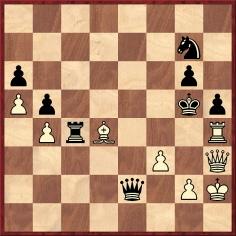
‘Jung v Szabados, Hungary, 1952.’ The Italian book gives ‘Szabadosz’, but we note two (Italian) players of the time who were named Szabados: Eugenio and Paolo. About White we know nothing.
Play is now stated to have gone 31 Bxg7 Rxh4 32 Qxh4+ Kxh4 33 Bf6+ g5 34 Bc3

Here Verkhovsky writes:
‘An extraordinary position of reciprocal Zugzwang. The black queen cannot control simultaneously the squares e1, e5 and f6 (in case of 34…g4) and continue to pin the g2 pawn. For this reason Black resigned. But if it had been White’s move in this position he would have been the one obliged to resign.’
In fact, in the second diagram above if it were White’s move he could still draw with any bishop move that did not put the piece en prise.
Presenting the position on page 204 of The Delights of Chess (London, 1960) Assiac had specified that it was from a 1952 match game between Jung and Szabados played not in Hungary but in Venice. After White’s move ‘4 Bc3’ he wrote:
‘Now, what with the queen saddled with the double duty of guarding e1 and keeping the g-pawn pinned, 4…Qf2 was absolutely forced, and after 5 Be5! Black might as well have resigned. He just tried to exploit White’s extreme time-pressure by 5…Qg1+ 6 Kxg1 g4 7 Bf6+ Kg3 8 Be5+ Kh4 9 f4 g3 10 Bf6+ Kg4 11 Bg5 Resigns.’
We shall appreciate information from readers about the complete score, the players, the occasion and the conclusion.
Assiac praised White’s play highly but speculated that ‘as likely as not, he was aware of a classic published by H. Cordes decades ago’:

This composition by Heinrich Cordes of Berlin won second prize in a Rigaer Tageblatt contest in 1895. White wins as follows: 1 Bc7 Qe1+ (1…Qxf2 2 Kh2) 2 Kh2 Qxf2 3 Bd6 Qf4+ 4 g3+. The study was widely published at the time (e.g. on page 288 of the September 1895 Deutsche Schachzeitung), and the following year (September 1896 issue, pages 257-259) F. Amelung took it as the inspiration for an article dealing with such themes as ‘Tempozugaufgaben’, ‘Tempozwang’ and ‘Reciproker Tempozugzwang’.
(2927)
Roland Kensdale (Aberdeen, Scotland) mentions that the Cordes study was featured in a spurious game ending created by J.A. Porterfield Rynd. See the article by John Roycroft on pages 646-648 of the December 2001 BCM and item 151 in Tim Krabbé’s Open Chess Diary on the Internet.
(2930)
C.N. 2927 above discussed whether the ‘Jung v Szabados’ game occurred in Venice or in Hungary. A further complication, pointed out by Richard Forster (Zurich), is that on page 279 of their book Combination in Chess (Budapest, 1965) G. Négyesy and J. Hegyi gave the venue as Dessau (in Germany).
(2935)
We are grateful now to Alan McGowan (Waterloo, Canada) for sending the following, from page 165 of the 11/1956 issue of Schach:
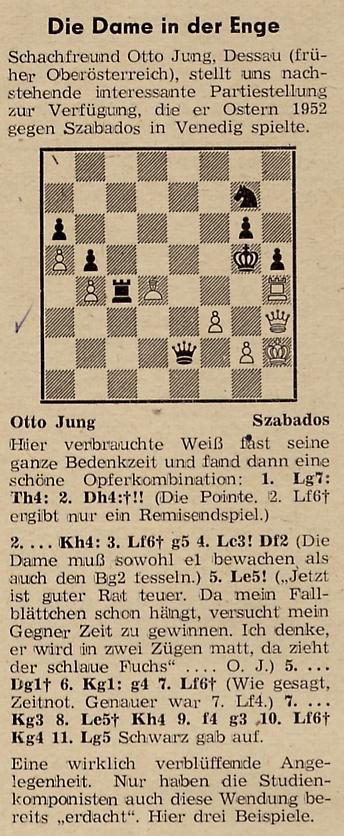
An outstanding point about this game (played in Venice in 1952, it is now known, although the full score has yet to be found) is whether Black was Eugenio or Paolo Szabados.
(4555)
Concerning the ‘Jung v Szabados’ position from the 1950s, publications noted have given the venue as Hungary, Venice and Dessau, and now Riccardo Del Dotto (Picciorana-Lucca, Italy) adds that August Livshitz offered a fourth version: Reggio Emilia. See, for instance, the second volume of Test Your Chess IQ (Oxford, 1981, page 32 and Oxford, 1989, page 26). Our correspondent also notes that the Zugzwang position had been the subject of compositions by Rinck and Troitzky, and he believes that the ‘Jung v Szabados’ ascription is false.
For further details see his article ‘Smascherato un falso storico?’. [Note on 13 September 2018: that link no longer works.]
(8403)
The Deutsche Schachzeitung (November 1899, pages 335-336) published this game:
Hippolyt Walter von Walthoffen – Johann Hermann Bauer
Correspondence, August 1886
Stonewall Attack
1 f4 d5 2 d4 e6 3 e3 c5 4 c4 Nf6 5 Nf3 Nc6 6 Nc3 a6 7 Ne5 cxd4 8 exd4 Bb4 9 a3 Bxc3+ 10 bxc3 Ne4 11 Qd3 Na5 12 c5 f6 13 Nf3 Nb3 14 Rb1 Nxc1 15 Rxc1 Qa5 16 Ra1 Qxc3+ 17 Qxc3 Nxc3 18 Bd3 Bd7 19 Kd2 Ne4+ 20 Ke3 Bc6 21 Bxe4 dxe4 22 Nd2 f5 23 Nc4 Bd5 24 Ne5 Rc8 25 Rac1 Rc7 26 g4 Rf8 27 g5 Ke7 28 a4 Rfc8 29 a5 Bc6 30 Rhg1 Rh8 31 Rg3 Kf8 32 Rh3 Kg8 33 Rc3 Be8 34 Rh4 h5
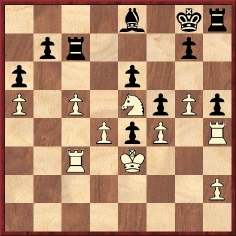
35 d5 exd5 36 Kd4 Bc6 37 Rb3 Rc8 38 Nxc6 bxc6 39 Rb6 g6 40 Rxa6 Rh7 41 Rb6 Ra7 42 a6 Kf7 43 Rh3 Ke7 44 Rhb3 Kd7 45 Rb7+ Rc7 46 R3b6 h4
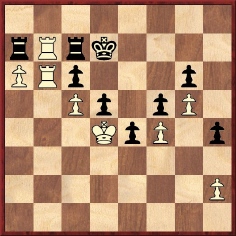
47 h3 (‘Zugzwang’, comments the German magazine.) 47...Kc8 48 Rxa7 Rxa7 49 Rxc6+ Rc7 50 Rxg6 Resigns.
(4723)
The above is an extract from our C.N. item.
Our article has remarked that the word ‘Zugzwang’ ‘was not commonly found in English-language chess literature prior to the publication of My System [in 1929]’. Here we add that a rare, early explanation of Zugzwang occurred in an (uncharacteristically florid) article by Hermann Helms entitled ‘Applying the Straitjacket in Chess’ which was originally published in the Brooklyn Daily Eagle and was reproduced on pages 65-66 of the March 1927 American Chess Bulletin. It concerned Capablanca’s celebrated victory (with the Caro-Kann Defence) over Nimzowitsch at New York, 1927, and Helms commented:
‘It was an artistic gem of the chessboard. Nimzowitsch is an artist. No-one appreciates beauty or perfection more than he. His own artistry has often dumbfounded opponents less skillful. But against the champion – that’s something different again.
Once more, that straitjacket; that is, the chessic kind. ... His little army was precisely as large as Capablanca’s. But he was cramped and he ached for elbow room. As to space and mobility he was much restricted. No matter which way he looked there was restraint. The prospect was decidedly irksome.
Very expressive is the German term of “Zugzwang”. It covers the case exactly. Literally translated it means move-coercion. The player thus unfortunately placed may be said to be position-bound. Gradually all his available moves are exhausted; that is, the moves that count at all. Then he faces the inevitable.
... Some move must be made. With that very move he signs his own death warrant ...
So it was with Nimzowitsch. He was the fly in the net. Capablanca played the part of spider. The Dane was already enmeshed. He made a brave show of resistance. The more he struggled the more hopeless became his plight. The Cuban looked pleased. On an occasion like this he fairly beams. His countenance yesterday radiated delight.’
(5147)
From W.E. Napier’s Amenities and Background of Chess-Play (published in three ‘units’, the first two in 1934 and the third the following year). The figure refers to the item number, given that the pages were unnumbered:
297. ‘Zugzwang is a very useful term. I sometimes think it is best defined by the story of the negro who drew a razor across the enemy throat:
Said the enemy, “I’m not cut.”
And the knight of the razor replied, “Just wait till you turn yo’ head, before guessing at it.”’
C.N. 6756 quoted a comment by C.J.S. Purdy on page 34 of the February 1960 Chess World:
‘Zugzwang just doesn’t happen in a middle-game. There is a win by Nimzowitsch against Sämisch in the middle-game which one annotator has called a “Zugzwang” finish. It is true that any move by Sämisch loses, but he would lose just as surely if his opponent had to move. It is not the compulsion to move that hurts him; his position is lost anyway. So it is no more Zugzwang than any other resignable position.’
From page 67 of Duels of the Mind by Raymond Keene (London, 1991):
‘This incredible game has been hailed as the “Immortal Zugzwang Game”. Chess is a game symbolic of warfare. Once this is accepted, is it too fanciful to imagine that Nimzowitsch’s conduct of this wonderful game was influenced by the trench warfare, the blockades which characterized World War I?’
Yes.
Page 111 of The Mammoth Book of The World’s Greatest Chess Games by G. Burgess, J. Nunn and J. Emms (London, 1998, 2004 and 2010) states:
As shown in the present article, we are aware of no instance of Lasker’s having used that exact phrase.‘Emanuel Lasker hailed this as the “Immortal Zugzwang Game”.’
(6768)
For the further information on Sämisch v Nimzowitsch, see pages 370-372 of Aron Nimzowitsch On the Road to Chess Mastery, 1886-1924 by Per Skjoldager and Jørn Erik Nielsen (Jefferson, 2012). The book gave an English translation of the winner’s notes on pages 213-214 of Kagans Neueste Schachnachrichten, April-June 1927.
Addition on 22 July 2011 (two C.N. items published in 1985):
The Oxford Companion to Chess (Oxford, 1984) describes Zugzwang as ‘a position in which each player would obtain a worse result if it were his turn to move than if it were not’. Later, it is remarked that ‘Zugzwangs occur only in the endgame, most frequently in pawn endings, occasionally in endings with knights, and rarely in endgames with line-pieces’.
The Sämisch-Nimzowitsch classic (Copenhagen, 1923) is given with this commentary: ‘White is at a loss for a good move in the final position, but it is not a Zugzwang. Black could lose the move in many ways; he can also make threats, and the position is not even a squeeze’. A squeeze (not a term we knew) is defined on page 321 as ‘a position in which one player must give ground only because he is obliged to move, as distinct from a Zugzwang when whoever has the move would be at a disadvantage. The position White Kd6 and Pc7, Black Kc8 is a Zugzwang: White to play would only draw, Black to play would lose, i.e. having the move would be disadvantageous for both Black and White. On the other hand the position White Kc7, Pb6 and Be2, Black Kc5 and Bc8 would be a squeeze: if Black were to move the pawn could be promoted and if White were to move he could make a waiting move (e.g. Bd3) with the same result; i.e. only Black is at a disadvantage because he has to move’.
In reply to a query as to whether Zugzwang really only occurred in the endgame, David Hooper challenged us to quote a middlegame example. We offered the following, from page 67 of Hugh Myers’ Exploring the Chess Openings (Davenport, 1978):

Myers-Lim, New York 1971
White has just played 36 b3 and gives the following annotation:
‘Black overstepped the time limit. It’s a case of absolute Zugzwang; White wouldn’t be able to win anything with the move, but he wins at least another pawn after any of Black’s 23 legal moves.’
Mr Hooper replied:
‘Your example, Myers-Lim, is certainly not a Zugzwang, for White can win if it is his turn to play (1 Khl). Nor is it a squeeze, for White can build up threats, apart from the fact that being a pawn up one might regard his position as won anyway. After Khl and Rh4 Black might answer 1...Kg8, when White wins by 2 Rxh6 Qxd4 3 Qh7+ Kf8 4 Nxe6+, for example.’
We passed these comments to Hugh Myers, who responded as follows:
‘I strongly disagree with Mr Hooper’s understanding of Zugzwang. It means “compulsion to move”, and common usage has given it a sense of negative consequences as a result of that compulsion. Nimzowitsch, in My System, talks about the position of the pieces of the player who must move, saying that Zugzwang is “when any change in their configuration can only be detrimental. In such a position his condition will get worse step by step until he is forced, by the necessity of making a move, to relax his hold on, or weaken, some key point, and his game collapses”. That means that Zugzwang can be a term applied to more than one particular position; it’s a downhill process in which the obligation to move, as compared to being given a right to pass, results in gradual deterioration of one’s game. However, pure Zugzwang is the unfortunate obligation to move in the culminating position: the player who must move will lose material or be mated (on the move or by the starting of a combination) by his opponent’s next move, even though the opponent would not be able to do either if it were his move in that position.
Mr Hooper’s statement that the final position of Myers-Lim “is certainly not a Zugzwang” is simply incorrect. It is a pure (or absolute) Zugzwang. Mr Hooper introduces two irrelevant factors:
1) “Being a pawn up one might regard his position as won anyway.” Might regard? So what? After going two pawns up, it would be clearly won. That is the result of the Zugzwang: making Black’s position clearly lost (Nimzo: “his game collapses”).
2) If it were White’s move, he could secure a won position by playing Khl (creating the same Zugzwang situation). This doesn’t make the particular position any less a Zugzwang situation. That definition is met by simply this: if it were White’s move, he would win nothing with that move; Black’s move must permit White to win material.
Mr Hooper has nothing to substantiate his very unclear definition of Zugzwang. At least it’s more understandable than “squeeze”, an apparently invented term.’
(923)
From David Hooper:
‘A chess position, examined as if it were White’s turn to play and also as if it were Black’s turn to play, falls into one of three categories according to its time characteristics:
(1) The obligation to make a move does not change the result of the game unfavourably.
(2) The side that has to move, be it Black or be it White, suffers decisive disadvantage because and only because it is his turn to play.
(3) The player to move will on this account alone suffer decisive disadvantage; the opponent to move will suffer no disadvantage thereby.
Category (1) positions occur throughout most of the game; having the move is usually desirable.
In the Companion category (2) positions are called Zugzwangs, and of these we can say, “whoever plays loses”, or “White plays and draws, Black to play loses”, or, “White plays and loses, Black plays and draws”. Neither player can change the result of the game by making threats.
Category (3) positions might well be sub-divided: (3a) those in which there is no other way to win, and (3b) those, such as that given by Mr Myers, in which a win might also be achieved by other means. In the Companion a position of type (3a) is called a squeeze. (3a) is so different from (2) that a separate name seems desirable. For a proper understanding of the endgame it is important to define both these types and to understand the difference between them.
The first use of the word Zugzwang, allegedly originated by Max Lange, needs to be determined – a fitting task for readers of Chess Notes, perhaps. Nimzowitsch, writing in the 1920s, is no doubt correctly quoted by Mr Myers. Later, Rinck attempted a more precise definition, but he used the word “blocus”, not Zugzwang. In 1954 Halberstadt labelled category (3a) Zugzwang and category (2) reciprocal Zugzwang. In 1972 I published an article (EG No. 29) using the words squeeze and Zugzwang. EG is the world’s leading periodical on the subject of basic endgame research and studies, and no reader denied the reality of the different categories. The Companion’s choice of terms, an attempt at standardization, may not meet with universal approval; but it is to be hoped that suitable terms will be established in due course.
Until consensus is reached, and perhaps a name (if required) is found for category (3b), Mr Myers is, of course, entitled to call his position a Zugzwang or any other word he chooses.’
(988)
As noted above, in the 1992 edition of The Oxford Companion to Chess the entries on Zugzwang and squeeze were revised.
Joose Norri (Helsinki) writes:
‘... In issue 29 of EG David Hooper defined Zugzwang and squeeze. The difference is clearly more important in studies.’
It will be seen that David Hooper’s detailed article referred to his definition of Zugzwang on pages 196-197 of A Pocket Guide to Chess Endgames (London, 1970). Our inscribed copy includes his handwritten errata sheet, dated 4 September 1971, and readers wishing to receive it are invited to contact us.
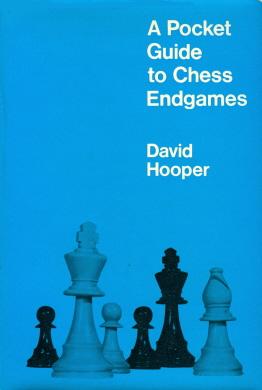
(5285)
See also the article ‘Drohung und Zugzwang’ by H. Keidanz (Keidanski) on pages 248-264 of the July-August 1911 Wiener Schachzeitung, as well as pages 387-388 of the November-December 1911 issue.
From page 88 of The Pleasures of Chess by Assiac (New York, 1952):
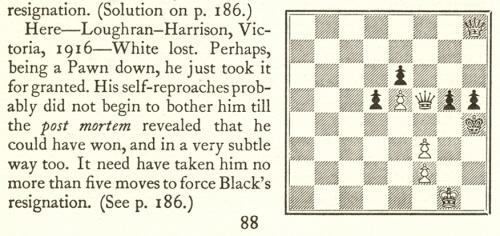
The solution on page 186:

Tracing the position backwards, we note, firstly, the following on page 42 of Chess Review, February 1935, in an article ‘Mistakes of the Masters’ by Lester W. Brand:
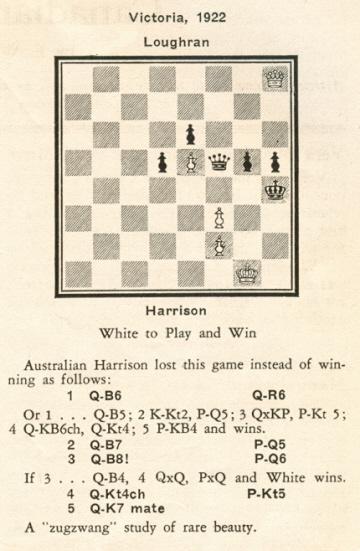
It will be seen that the players’ names are inverted compared to Assiac’s version, with a different date (1922 instead of 1916).
A more detailed account of the ending was given on page 262 of the August 1916 BCM:
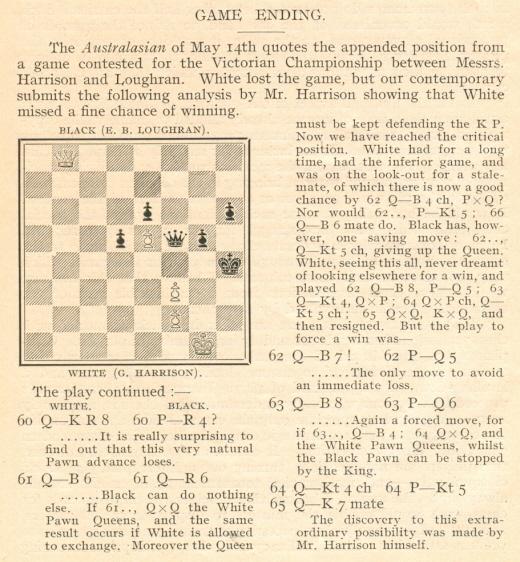
A crosstable of the championship of Victoria, a double-round tournament played in Melbourne from 19 April to 21 July 1916, was presented in volume one of The Records of Australian Chess by John van Manen (Modbury Heights, 1986). Compiled from reports in the Australasian, April-July 1916, the crosstable shows that Loughran scored a win and a draw against Harrison.
Can further information be found about the above Harrison v Loughran game?
(7001)
Christian Sánchez comments that in various editions of Kurt Richter’s books Schachmatt and Kombinationen the game ending was given as either Harrison v Longhran or Longhran v Harrison (and not with the correct spelling Loughran).
Our correspondent adds that he has the conclusion of the game in a database with a specific date (26 April 1916). What is the source of that information?
(7007)
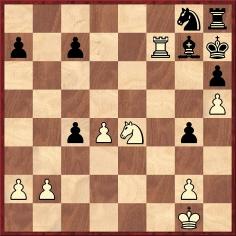
Black resigned.
‘One of the most elaborate blockades and Zugzwangs ever’ and ‘altogether a most wonderful conception’. So wrote Bruce Hayden about a game on pages 58-61 of Cabbage Heads and Chess Kings (London, 1960):
1 e4 e5 2 Nc3 Nc6 3 f4 exf4 4 Nf3 g5 5 h4 g4 6 Ng5 h6 7 Nxf7 Kxf7 8 d4 d5 9 Bxf4 dxe4 10 Bc4+ Kg6 11 O-O Bg7 12 h5+ Kh7 13 Be5 Bxe5
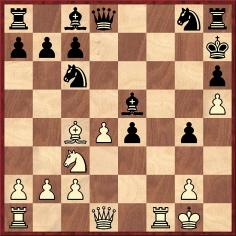
14 Rf7+ Bg7 15 Nxe4 Qxd4+ 16 Qxd4 Nxd4 17 Raf1 Bf5 18 c3 b5 19 cxd4 bxc4 20 R1xf5 Re8 21 Re5 Rf8 22 Ree7 Rxf7 23 Rxf7 Resigns.
The book merely stated that ‘Herr Hartewige’ won the game in Chemnitz in 1901. When Hayden originally published the item (Chess Review, March 1953, pages 76-77), the loser was mysteriously named as ‘Herr Neinzwanger’.
White was Emil Johann Hartewig (1861-1932), and when he annotated the game on pages 174-175 of the June 1902 Deutsche Schachzeitung he identified his opponent as ‘R. F....i’:
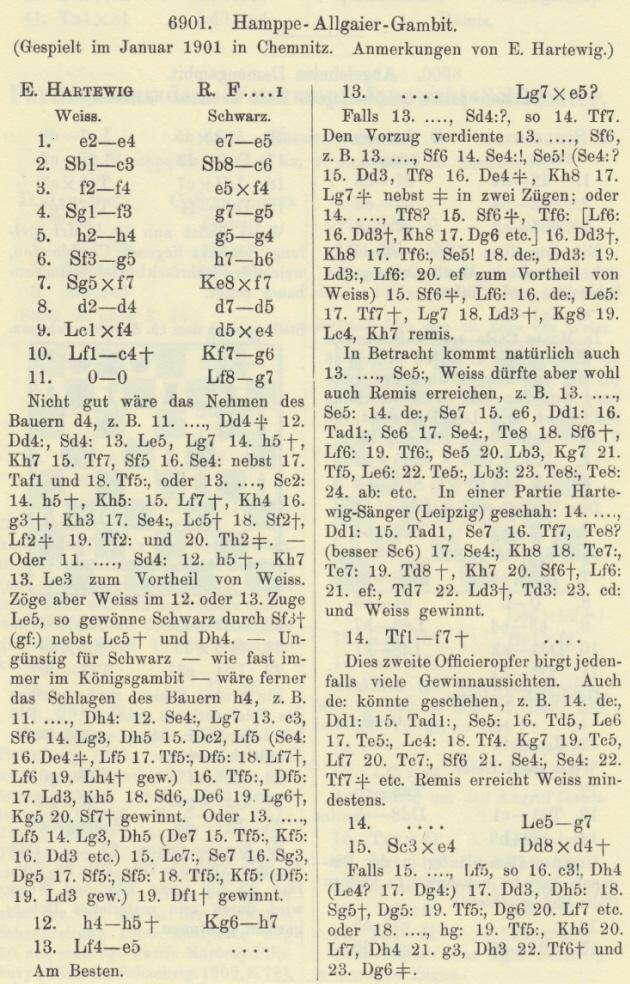
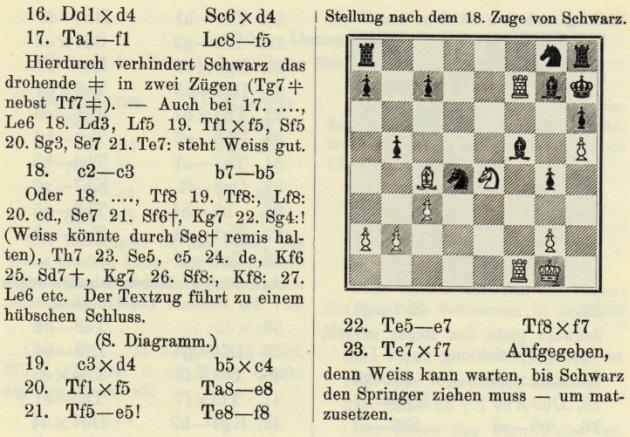
Can any further details be found?
(8147)
A note to 33 b3 in a Morphy v Löwenthal game on page 127 of 500 Master Games of Chess by S. Tartakower and J. du Mont (London, 1952):
‘Reaching a curious case of Zugzwang on an open board.’
In the entry on Zugzwang on page 223 of Dictionary of Modern Chess by Byrne J. Horton (New York, 1959) the word was misspelt four times:
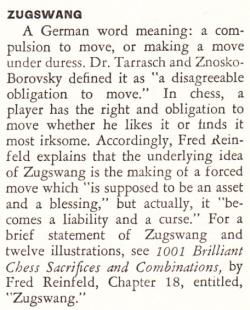
Old attempts to explain Zugzwang are always welcome. The following reply to a correspondent comes from page 154 of the September 1902 Schweizerische Schachzeitung:
‘E.H., Lausanne. La signification de Zugzwang est littéralement “contrainte de jouer”. Cela veut dire que les Noirs répondant au 1er coup des Blancs, sont obligés de se mettre sous un mat dont ils ne seraient même menacés s’ils pouvaient déranger aucune pièce.’
(8615)
On page 108 of Great Moments in Chess (New York, 1963) Fred Reinfeld described 25...h6 as ‘the most remarkable concluding move ever made in a game of chess’.
A book on Zugzwang is You Move ... I Win! by Alex Angos (Davenport, 2005).
From page 32 of Wie erlernt man schnell und leicht das Schachspiel by Jacques Mieses (Berlin, 1903):

We have set out some authorities’ disagreement over the precise meaning of the German term in descriptions of chess play, but which games are most likely to be accepted as ‘ideal’ illustrations?
On the inside front cover of the June 1951 Chess Review Irving Chernev gave the game Jan Schulz v Bedřich Thelen, Prague, 1927, introduced as follows:
‘Even the great Houdini could not have wriggled out of this paralyzing Zugzwang.’
1 Nc3 c5 2 e4 Nc6 3 Nf3 e6 4 d4 cxd4 5 Nxd4 a6 6 a4 Qc7 7 Be2 Nf6 8 O-O Be7 9 Be3 O-O 10 Qd2 d6 11 Nb3 Kh8 12 a5 Nd7 13 Na4 Bd8 14 Nb6 Nxb6 15 axb6 Qb8 16 Rfd1 Be7 17 c4 Nd8 18 c5 dxc5 19 Bxc5 Nc6 20 Bxe7 Nxe7 21 Qb4 Ng6 22 Rd6 h6 23 Rad1 Kh7 24 g3 Ne7 25 Na5 f5 26 Rd8 Rxd8 27 Rxd8 Ng6 28 exf5 exf5 29 f4 Resigns.
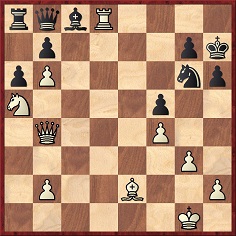
Chernev reproduced his item on pages 192-193 of The Chess Companion (New York, 1968), without correcting his duplication of numbers at move 21.
Below is the game, played on 23 January 1927, as given with the winner’s notes on page 25 of Československý šach, February 1927:
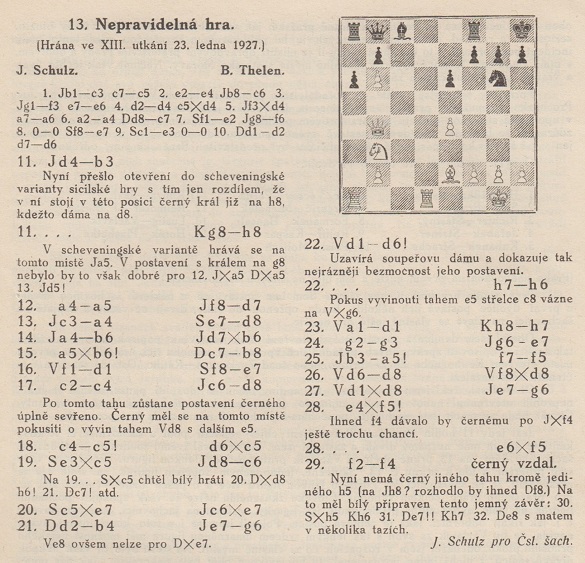
(9994)
From page 52 of C.J.S. Purdy, His Life, His Games, and His Writings by J. Hammond and R. Jamieson (Melbourne, 1982):
‘“Zugzwang” is the glorious untranslatable German word, meaning “the plight of having to move”.’
On page 237 of Capablanca’s Best Chess Endings (Oxford, 1978) Irving Chernev commented:
‘I would venture to say that Capablanca has won more games by Zugzwang than has any other master.’
From an article entitled ‘Promotion, Zugzwang, Stalemate’ by C.J.S. Purdy on pages 81-83 of Chess World, 1 April 1949:
‘Zugzwang is the only kind of combination which doesn’t start with a threat, check or capture. Indeed, except when the motif of Zugzwang enters, every move by the attacker in every combination must be a threat, check or capture. That is why you can always say exactly when a combination begins and ends.’
(10837)
Old instances of the word Zugzwang, in German publications and in other languages, are always welcome. As mentioned in Earliest Occurrences of Chess Terms, the Oxford English Dictionary gives the following from page 166 of Lasker’s Chess Magazine, February 1905:
‘White has struggled bravely and only loses by “Zugzwang”.’
The comment came at the end of the magazine’s coverage of the third match-game between Marshall and Janowsky, Paris, 28 January 1905, after 50...f6:
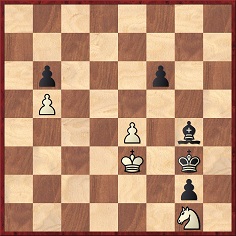
(10838)
Addition on 26 March 2025:
From page 4 of the Ulster Echo, 19 December 1894:
‘The position is a perfect example of what the Germans call Zugzwang.’
As mentioned at the end of C.N. 10173, the point of nicknames is seldom clear. One that has not caught on is ‘the Hector of Chess’ (Nimzowitsch), which appeared on page 89 of Technique in Chess by Gerald Abrahams (London, 1961):
‘Nimzowitsch reduced Sämisch to Zugzwang in some 22 moves, and Alekhine, playing avenging Achilles, reduced the Hector of Chess to Zugzwang in a game of comparable shortness [at San Remo, 1930].’
(10884)
Regarding the latter game, see Alekhine’s Gun.
C.N. 2225 (see our feature article on Pal Benko for the full item) remarked concerning his article in the December 1998 Chess Life:
Sämisch v Nimzowitsch, Copenhagen, 1923. A reader raises the subject of the ‘Immortal Zugzwang Game’ and quotes a definition of Zugzwang by ‘a most knowledgeable authority’, Golombek. In reality, the definition was written by Wolfgang Heidenfeld. Golombek was on record as calling the Nimzowitsch victory ‘the finest possible example of Zugzwang’, whereas Heidenfeld’s view was that the game did not feature Zugzwang at all.
Wolfgang Heidenfeld’s entry on Zugzwang on pages 351-352 of The Encyclopedia of Chess (London, 1977) was absent from the Penguin edition of 1981. The latter book did, however, have an item on Zugzwang by David Hooper in the Endgame section, on page 143.
From page 388 of the American Chess Magazine, March 1899:
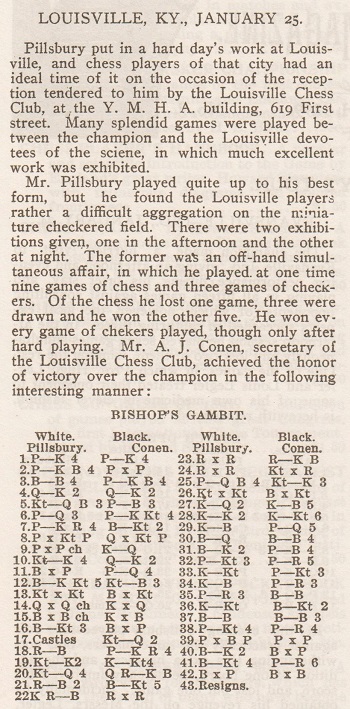
The game is by no means unknown and can be found, for instance, on page 299 of Harry Nelson Pillsbury American Chess Champion by J.N. Pope (Ann Arbor, 1996).
It is worth also noting its appearance on page 70 of the May-June 1939 American Chess Bulletin:
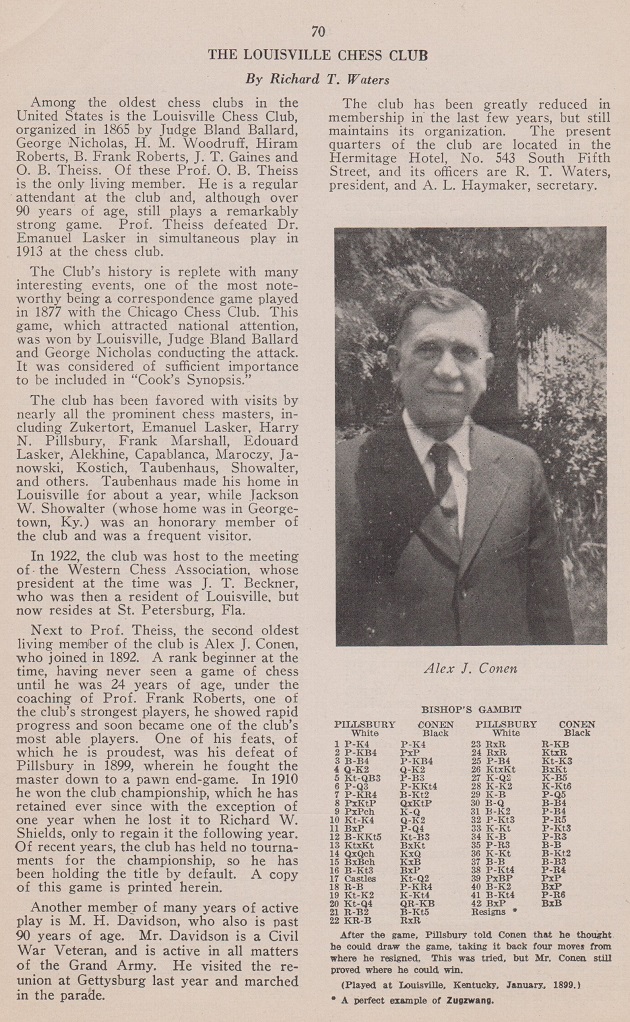
1 e4 e5 2 f4 exf4 3 Bc4 f5 4 Qe2 Qe7 5 Nc3 c6 6 d3 g5 7 h4 Bg7 8 hxg5 Qxg5 9 exf5+ Kd8 10 Ne4 Qe7 11 Bxf4 d5 12 Bg5 Nf6 13 Nxf6 Bxf6 14 Qxe7+ Kxe7 15 Bxf6+ Kxf6 16 Bb3 Bxf5 17 O-O-O Nd7 18 Rf1 h5 19 Ne2 Kg5 20 Nd4 Raf8 21 Rf2 Bg4 22 Rhf1 Rxf2 23 Rxf2 Rf8 24 Rxf8 Nxf8 25 c4 Ne6 26 Nxe6+ Bxe6 27 Kd2 Kf4 28 Ke2 Kg3 29 Kf1 d4 30 Bd1 Bf5 31 Be2

31...c5 32 b3 h4 33 Kg1 b6 34 Kf1 a6 35 a3 Bc8 36 Kg1 Bb7 37 Bf1 Bc6 38 b4 a5 39 bxc5 bxc5 40 Be2 Bxg2 41 Bg4 h3 42 Bxh3 Bxh3 43 White resigns.
When the Sämisch v Nimzowitsch game was given on pages 115-116 of The Golden Treasury of Chess by Francis J. Wellmuth (Philadelphia, 1943) the heading was ‘The Evergreen Zugzwang Game’.
See too The So-called Fahrni-Alapin Pawn Ending.
See also Articles about Aron Nimzowitsch.
To the Chess Notes main page.
To the Archives for other feature articles.
Copyright: Edward Winter. All rights reserved.